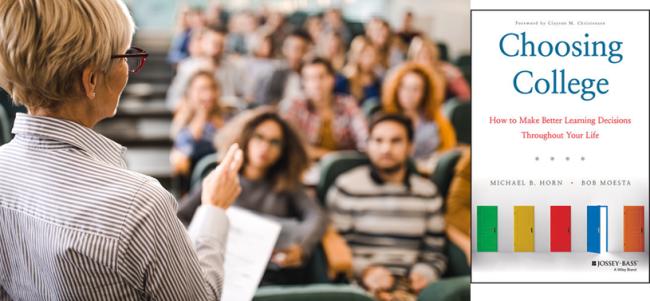You have /5 articles left.
Sign up for a free account or log in.

Istockphoto.com/skynesher
The launch of a new academic year brings with it books on how to choose college. One book out this fall, Choosing College: How to Make Better Learning Decisions Throughout Your Life (Wiley), takes a slightly different approach: it explores college-going simultaneously for students and parents, assuming both groups will make plenty of mistakes before arriving at what one hopes will be a good choice. Notably, the book includes 200 stories of students, both those headed for top colleges and those for whom a year or two off may be the right choice (for now).
The authors of the book are Michael Horn, head of strategy for the Entangled Group, a venture capital group and research organization, and Bob Moesta, co-founder and president of the ReWired Group, which helps companies innovate. Horn answered questions about the book.
Q: Every year brings more books on how to get into college. What makes your book different?
A: We intentionally don't tackle the question of how to get into college. Instead we answer a more foundational question everyone should ask first, which is why? Why are you seeking more education in your life? Or why should you? What is the progress you are trying to make? Once people know the answer to that question, then they'll be ready to make a better choice around college -- or whatever educational program they pursue next. And then they can consult other books and sources of advice on how to get in.
In our research we collected and analyzed more than 200 personal stories and surveys of more than 1,000 students who have chosen different paths for higher education to understand what was causing them to enroll -- not correlated with them enrolling -- which gives us unique insight into this question of why.
Q: You include cartoons at the end of chapters with what not to do and what to do. Why did you include them?
A: We really wanted to make this book accessible to parents and students so they could take our findings and translate them into actionable steps. I admire how authors like Adele Faber and Elaine Mazlish -- the authors of How to Talk So Kids Will Listen -- and Daniel Pink in The Adventures of Johnny Bunko have used cartoons to convey complex ideas with simplicity that people can grasp quickly. The cartoons at the end of several of the chapters distill several pieces of advice for parents so they can imagine real scenarios their children might face around their educational pathway, how their children might talk about that situation and then how parents should -- and should not -- respond.
Q: You say to ignore the rankings. Why?
A: Fundamentally all the rankings fail to account for one crucial question whose answer varies radically depending on the student: Why are you going to college? The rankings are all likely out of step with the progress an individual is trying to make. None give students the information and context they need to make such a high-stakes decision.
Quality and value aren’t absolute. They can only be measured in relation to why someone is purchasing something and the outcome they desire. Averages mislead. What’s worse, these rankings have helped set the terms of the rat race that results in students bending over backwards to get into the “best” school -- as if there is only one -- and families descending into the immoral and illegal behavior revealed in the Varsity Blues admissions scandal. They also cause schools to change their programs to look good against the criteria -- or even in some cases falsify data -- all in an effort to climb the artificial rankings lists.
More important for students than stressing out about whether they will get into a highly ranked school according to a one-size-fits-all system is figuring out the right fit for them -- at this point in their lives.
Q: Some of the book features stories about students for whom college is not the right choice -- at least at the time. Why?
A: In our society we've created a narrative that you have to go to college, yet we know that not all students who go to college are successful. We also know empirically that there are other pathways that can result in positive outcomes. Although going to college is a wise decision on average, no one is average. By telling real stories of people for whom college wasn't the right choice, we hope to help individuals recognize themselves in a story and be able to see when college might be the perfect next step -- and when it might not be.
To be clear, just as you asked, just because someone isn't ready for college right now, doesn't mean they won't be at some point. It's just important to understand the context you're experiencing right now so you can properly weigh that decision.
Q: You write to parents as well as students. What do you hope parents take away from your book?
A: I hope parents take away two big ideas -- how to talk to their children about the college decision and how to make better decisions in their own life around learning given that we're all lifelong learners.
On the first -- every parent knows the feeling where you feel like you can see the larger picture, you have a sense for your child and what would be good for them, but your child has just tuned you out. You talk to them then, and they can’t believe how little you understand what they are feeling and what they are going through. They just don’t want to hear it. My hope is that this book will serve as a Rosetta Stone of sorts for parents by giving them the code for how their children are talking about and viewing the choices around college. We captured the real language of students across our more than 30,000 data points -- and that language is remarkably similar from person to person who has roughly the same why for going. Importantly, I hope parents take away that their job isn’t to solve their child’s problems or figure it out for them. That struggling moment your child is going through is the seed of innovation and a teachable moment. The real problem comes if a parent swoops in to help their child avoid the struggle by reducing the friction before she has wrestled with the full dimension of it. Instead, the key is to coach her through it.
On the second -- I hope that as parents pick up the book to help their children, they will realize that our framework and conclusions can be applied to anyone who is a lifelong learner and trying to improve continually and challenge themselves and that they'll use it to enhance their own life.




